Inflection Point Effect of Interturn Insulation for Transformer under Preload Stress
Abstract
:1. Introduction
2. Experimental Methods
2.1. Experimental Platform
2.2. Experimental Materials
2.3. Experimental Preprocessing
2.4. Pressurization Method
2.5. Post-Experimental Processing
3. Experimental Result
3.1. Statistical Parameters of Partial Discharge for Interturn Insulation under Preload and Electrical Stress
3.2. Changes in Microstructure of Interturn Insulation Paper after Breakdown
3.2.1. Microscopic Morphology Analysis
3.2.2. Fourier Transform Infrared (FTIR) Spectroscopy Analysis
3.2.3. X-ray Diffraction (XRD) Analysis
3.2.4. Energy-Dispersive Spectroscopy Analysis
4. Effect Mechanism of Preload and Electrical Stress Synergism on Interturn Insulation Discharge
4.1. Influence Mechanism of Preload on Turn Insulation Discharge
4.2. Influence Mechanism of Electrical Stress on Interturn Insulation Discharge
5. Conclusions
Author Contributions
Funding
Data Availability Statement
Acknowledgments
Conflicts of Interest
References
- Zheng, H.; Zhai, J.; Li, Z.; Chen, X.; Pu, B. An assessment of ability to withstand radial short circuit of large power transformer inner windings. Power Syst. Prot. Control 2016, 44, 154–158. [Google Scholar]
- Zhang, K.; Zhan, R.; Du, D.; Zhan, Z.; Liu, H. Internal short circuit current calculation and dynamic simulation of converter transformer. High Volt. Eng. 2024, 50, 1621–1630. [Google Scholar]
- Ding, H.; Zhao, W.; Diao, C.; Li, M. Electromagnetic Vibration Characteristics of Interturn Short Circuits in High Frequency Transformer. Electronics 2023, 12, 1884. [Google Scholar] [CrossRef]
- Wei, X.; Pei, Z.; Nie, H.; Li, L.; Wang, Y.; Chen, Q. Partial discharge tests and researches in power transformer interturn insulation under step-stress. Electr. Mach. Control 2017, 21, 49–57. [Google Scholar]
- Wei, X.; Li, L.; Nie, H.; Pei, Z.; Wang, Y. Electrical aging characteristic of 500 kV power transformer turn-to-turn insulation model coils. Electr. Mach. Control 2017, 21, 17–24. [Google Scholar]
- Cheng, Y.C.; Wei, J.Q.; Li, C.R.; Rong, Z.H.; Wang, G.Z.; Ma, Z.L. Development Rules of Accelerated Degradation of Oil-Paper Insulation between Turns in Transformer Windings Induced by Partial Discharge. Trans. China Electrotech. Soc. 2015, 30, 203–212. [Google Scholar]
- Zhao, Y.K.; Zhang, G.Q.; Guo, R.R. Study on discharge characteristics of heat resistant interturn insulation materials in power transformers. Adv. Technol. Electr. Eng. Energy 2019, 38, 1–9. [Google Scholar]
- Zhao, Y.; Zhang, G.; Guo, R.; Yang, F. The breakdown characteristics of thermostable insulation materials under high-frequency square waveform. IEEE Trans. Dielectr. Electr. Insul. 2019, 26, 1073–1080. [Google Scholar] [CrossRef]
- Hu, E.; Zhao, W.; Xu, T.; Xu, J.; Liang, S. Effect of sulfur corrosion on the characteristic of partial discharge in turn-to-turn winding insulation in power transformer. High Volt. Appar. 2020, 56, 216–223. [Google Scholar]
- Guo, R.; Sun, Y.; Zhang, X.; Wu, J.; Li, J. Discharge characteristics of actual winding turn-to-turn structure inside transformers under oscillating switching impulse voltage. In Proceedings of the International Symposium on High Voltage Engineering, Xi’an, China, 21–26 November 2021; pp. 666–669. [Google Scholar]
- Liu, Y.; Liu, G.; Li, L.; Wu, W. Simulation and analysis of turn-insulation on temperature rise and hot spots of transformer windings. J. North China Electr. Power Univ. 2020, 47, 64–73. [Google Scholar]
- Liu, J.; Wang, F. Study on the influence of preload on the thermal aging of transformer oil-paper insulation. Electr. Mach. Control 2020, 24, 127–134. [Google Scholar]
- Liu, Y.; Yan, C.; Wang, B.; Zhou, X. Influence of different factors on thermal ageing characteristics of transformer insulating pads. Insul. Mater. 2023, 56, 52–59. [Google Scholar]
- GB/T 1408.1-2016; Test Methods for Electrical Strength of Insulating Materials—Part 1: Power Frequency Test. Standardization Administration of China. China Standards Press: Beijing, China, 2016.
- Zhang, F.; Li, X.; Zhu, X.; Zhuang, Z.; Shi, Y. Assessment of the withstand ability to short circuit of inner-windings in power transformers considering the degreeof thermal aging. Proc. CSEE 2022, 42, 3836–3845. [Google Scholar]
- Munajad, A.; Subroto, C.; Suwarno. Fourier Transform Infrared (FTIR) Spectroscopy Analysis of Transformer Paper in Mineral Oil-Paper Composite Insulation under Accelerated Thermal Aging. Energies 2018, 11, 364. [Google Scholar] [CrossRef]
- Li, X.; Wu, G.; Yang, Y.; Wang, Z.; Xu, P.; Li, Y.; Gao, B. Partial discharge characteristics of oil-paper insulation for on-board traction transformers under superposed inter-harmonic AC voltages. IEEE Trans. Dielectr. Electr. Insul. 2020, 27, 240–248. [Google Scholar] [CrossRef]
- Li, X.; Zhang, W.; Wang, H.; Ma, X.; Zhang, H.; Li, K.; Qin, T.; Liu, K.; Yang, Y.; Wu, G. Surface degradation of oil-Immersed nomex paper caused by partial discharge of high-frequency voltage. J. Electron. Mater. 2023, 52, 1094–1103. [Google Scholar] [CrossRef]
- Zhang, Q.; Han, X.; Zhang, Z.; Pang, P.; Sun, Z. Influences of Internal Void Defect Dimension and Position on Partial Discharge Characteristics in the Solid Insulation. High Volt. Eng. 2019, 45, 1313–1322. [Google Scholar]
- Tang, C.; Liao, R.; Huang, F.; Yang, L.; Zhu, M. The breakdown voltage of power transformer insulation paper after thermal aging. Trans. China Electrotech. Soc. 2010, 25, 1–8. [Google Scholar]
- Li, X.; Li, J.; Sun, C.; Dang, J.; Li, Y. Study on electrical aging lifetime of vegetable oil-paper insulation. Proc. CSEE 2007, 27, 18–22. [Google Scholar]
- Prevost, T.A.; Oommen, T.V. Cellulose insulation in oil-filled power transformers:Part I-history and development. IEEE Electr. Insul. Mag. 2006, 22, 28–35. [Google Scholar] [CrossRef]
- Xiang, B.; Liao, R.; Zhang, Y.; He, L.; Zhou, T. AgingMicro-mechanism of Oil-paper Insulation in Power Transformers by XRD Analysis. High Volt. Appar. 2012, 48, 40–45. [Google Scholar]

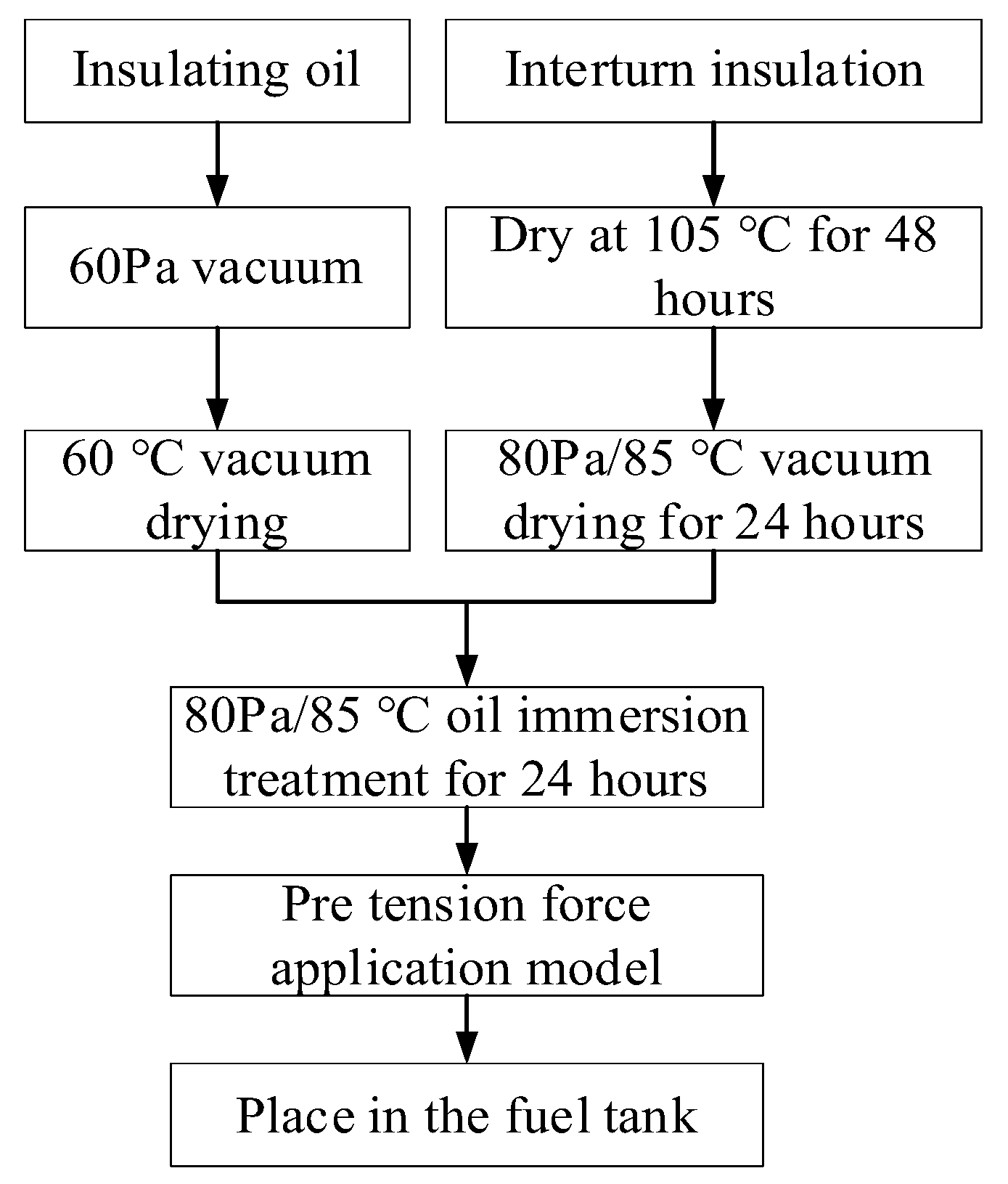


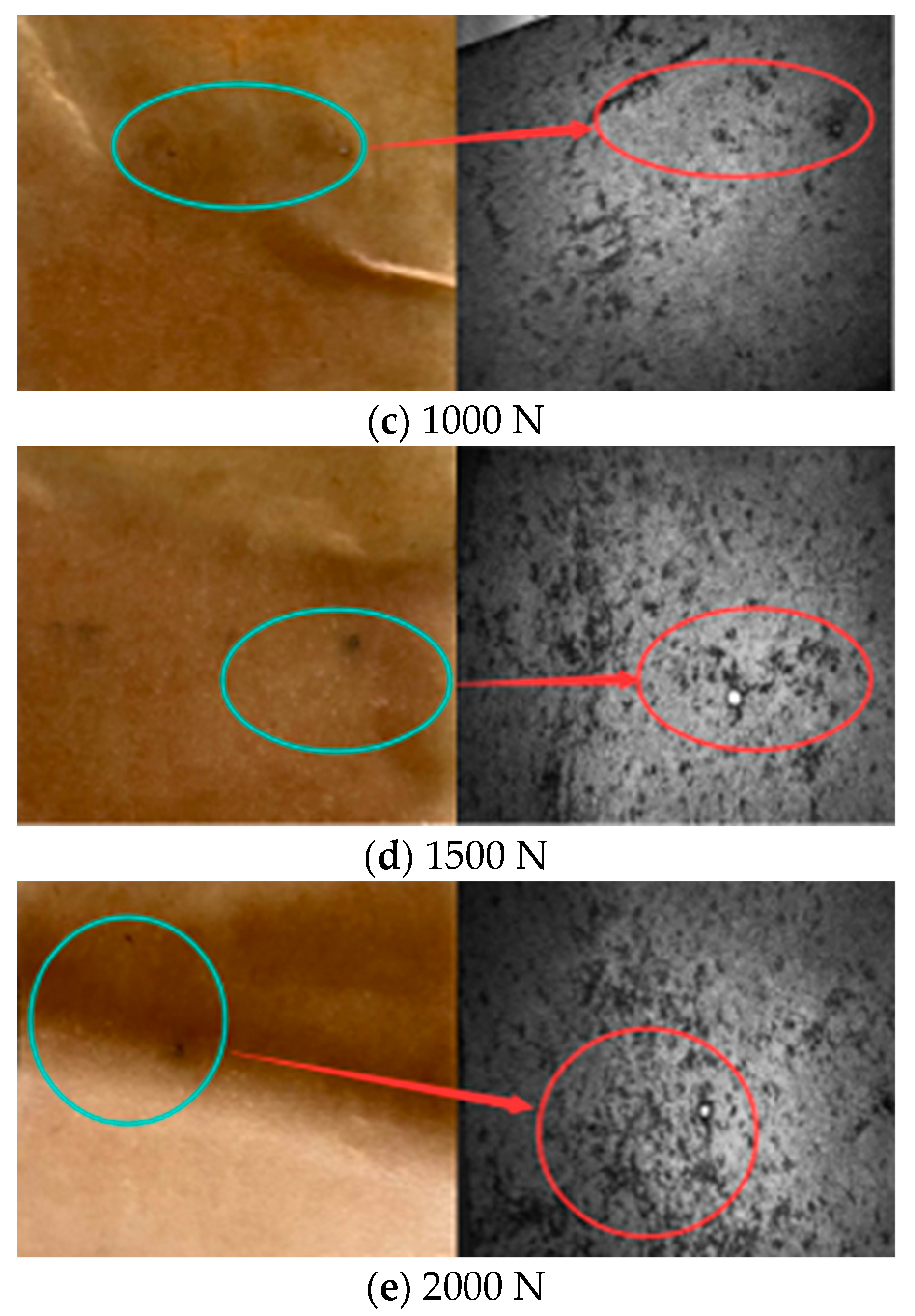
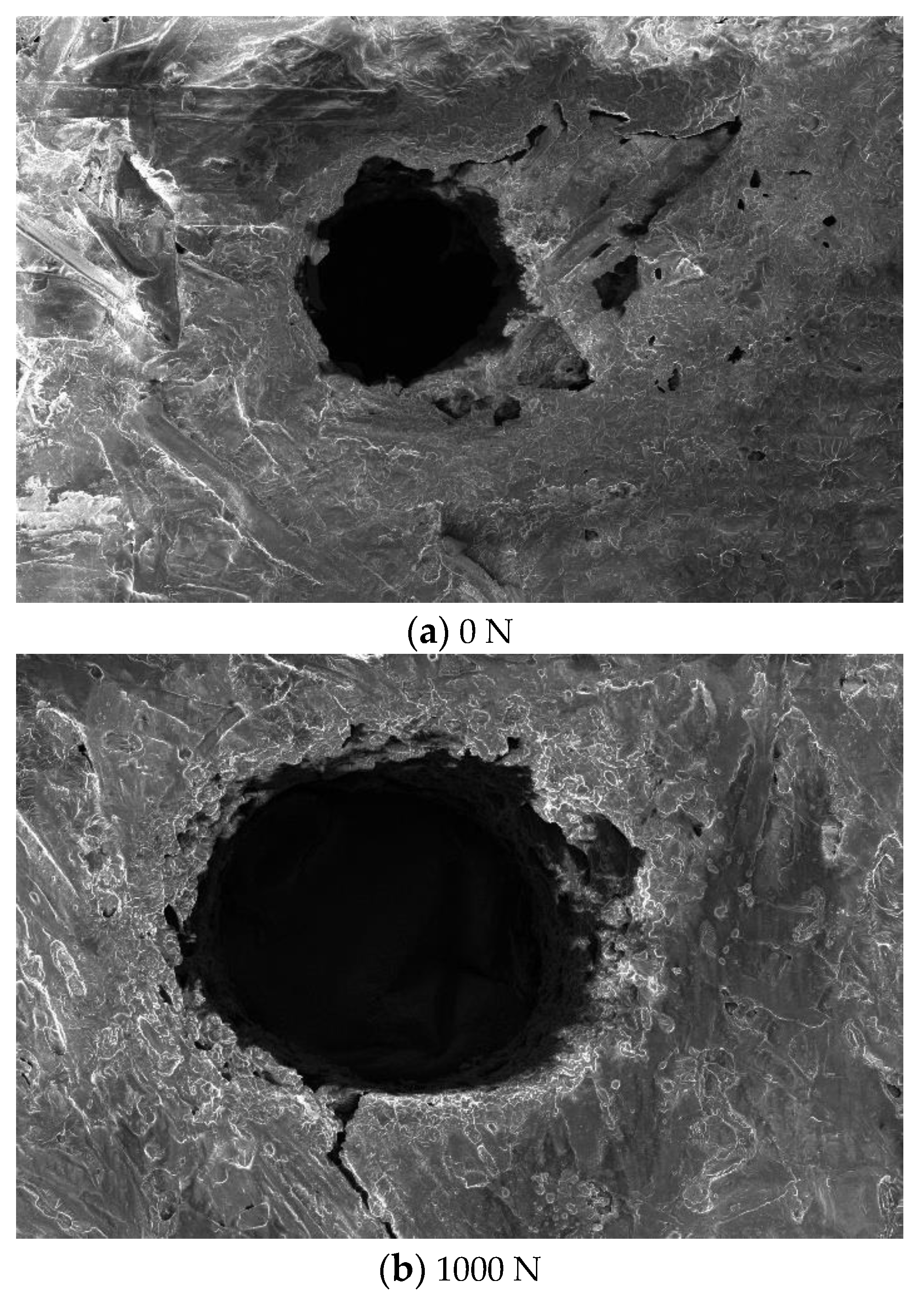

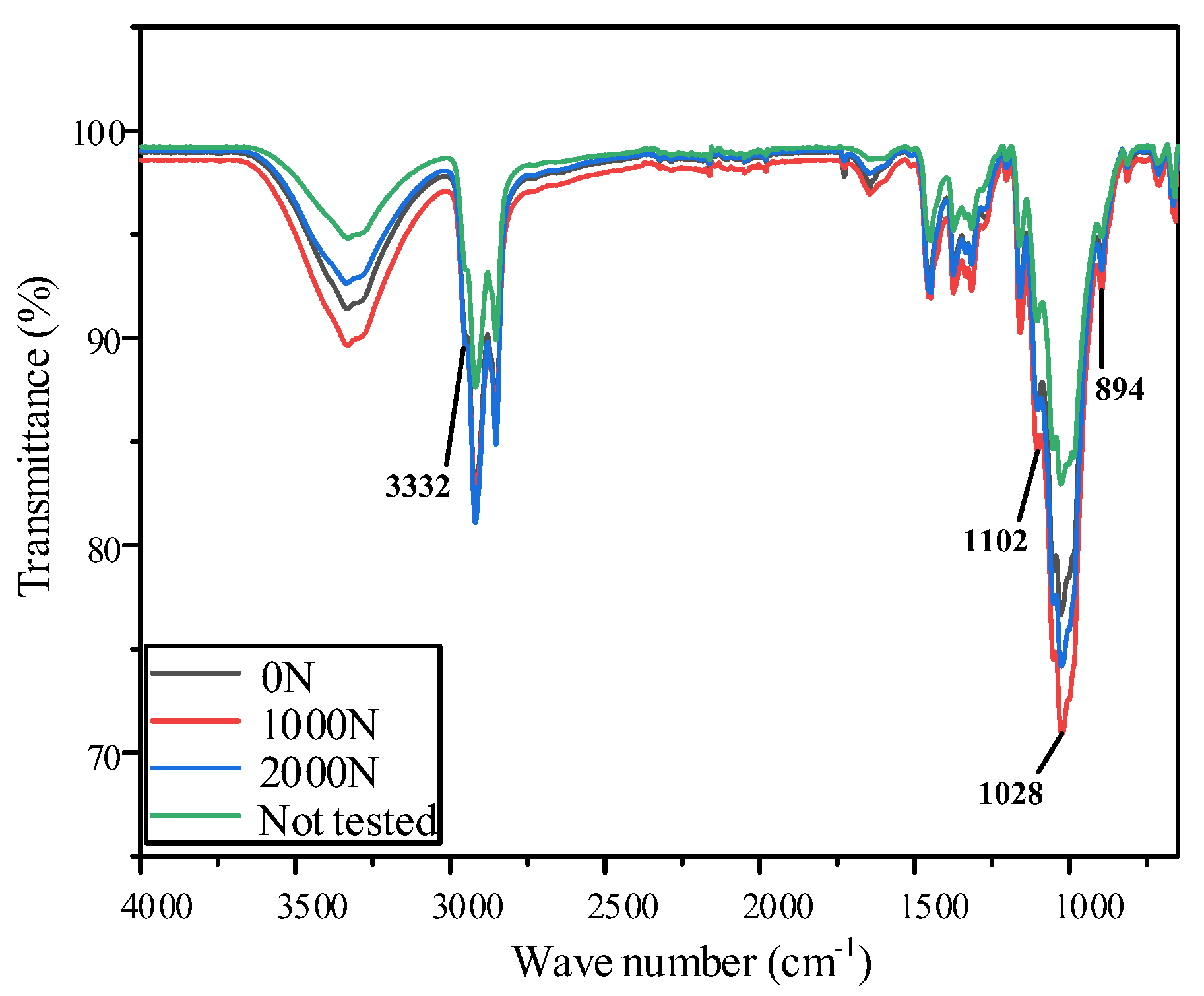
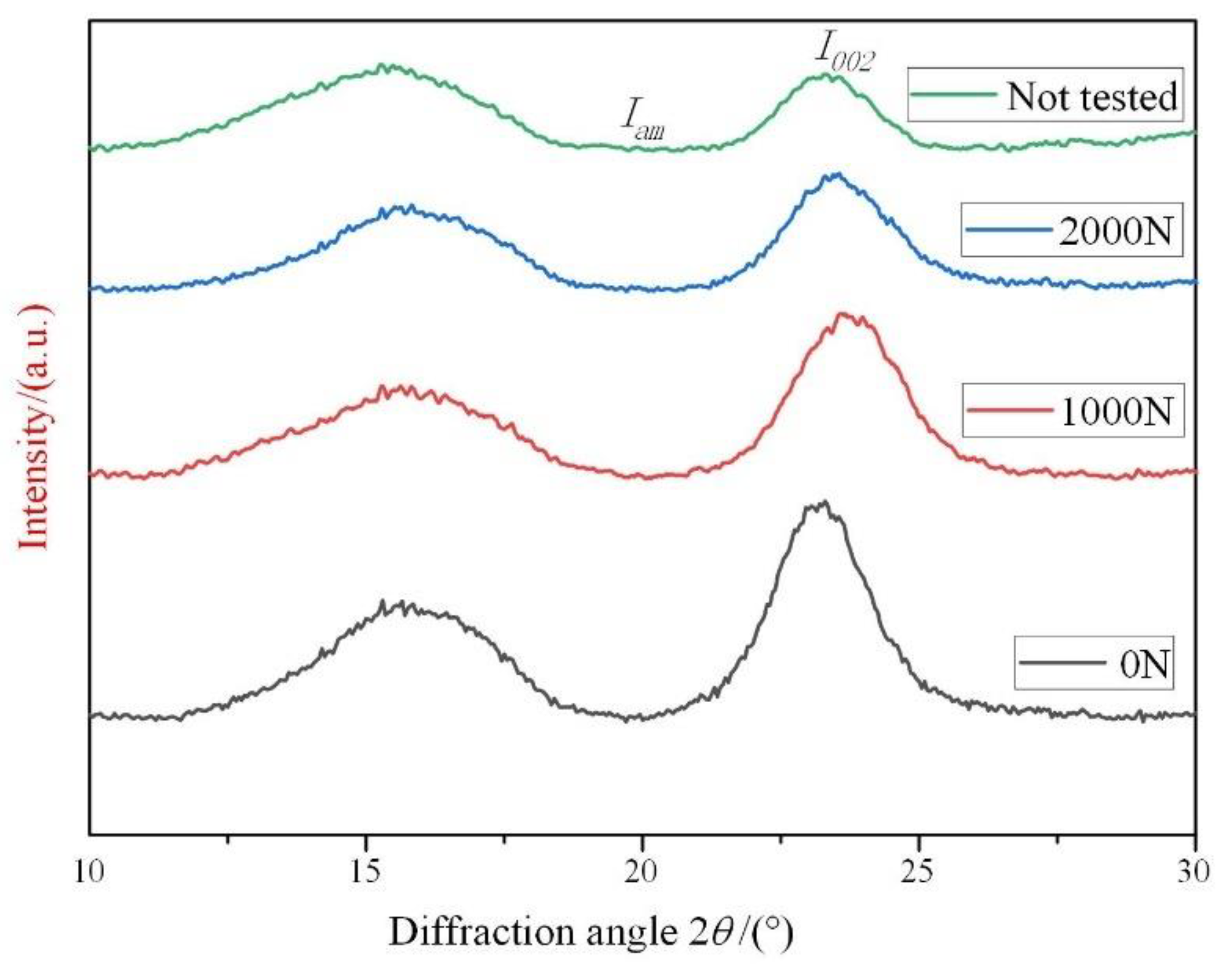
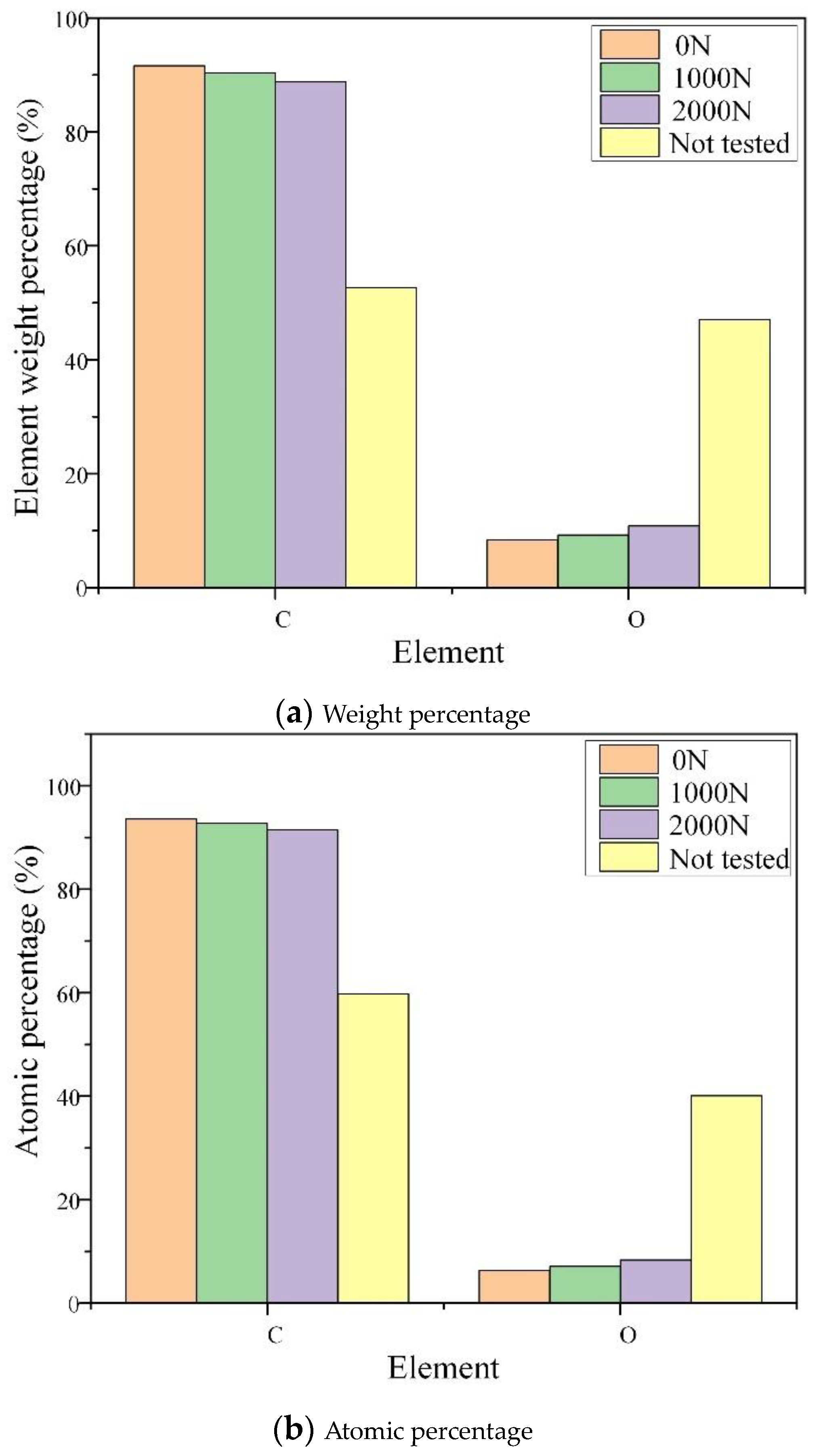



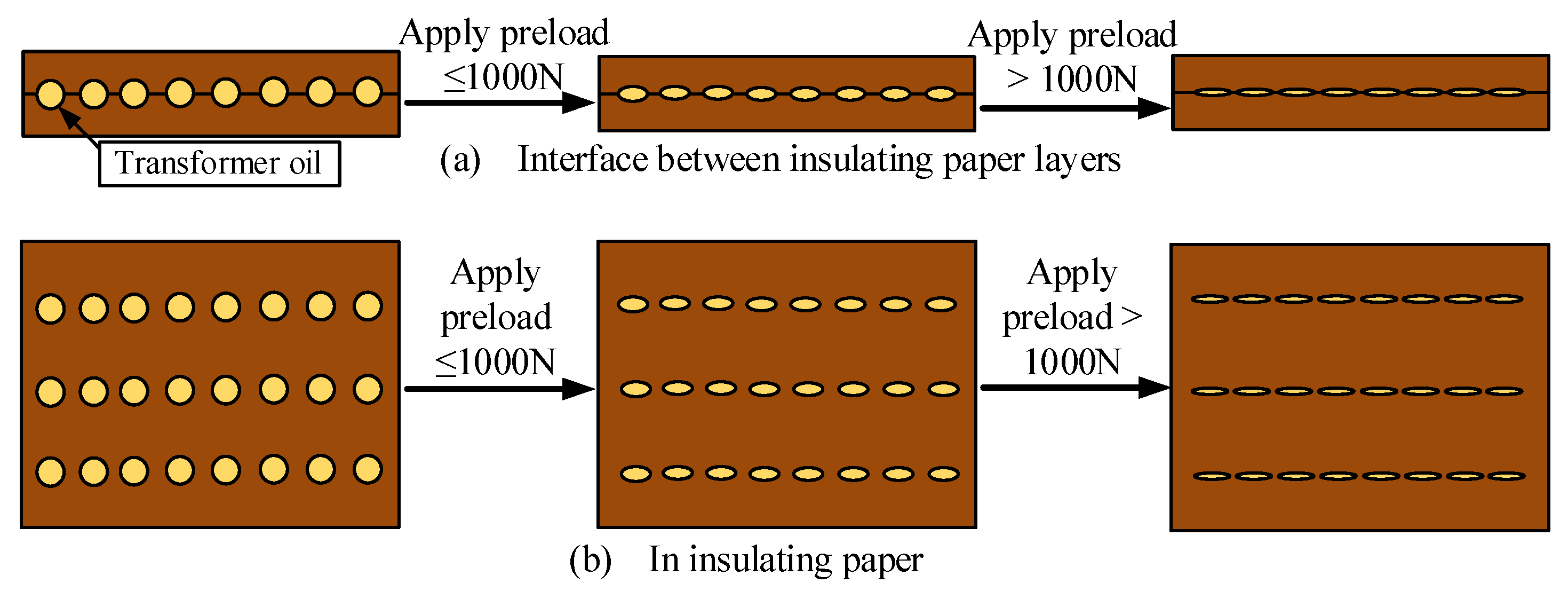


| Experimental Materials | Material Type | Set Size |
|---|---|---|
| Flat copper strip | copper | 250 × 20 × 2 mm |
| Insulating paper | Kraft paper | 0.13 mm |
| Insulating oil | 25# transformer oil | / |
| Applying Voltage | Interstage Increment | Duration |
|---|---|---|
| U ≤ 5 kV | 0.2 kV | 2 min |
| 5 kV < U ≤ 15 kV | 2 kV | |
| U > 15 kV | 1 kV |
| Absorption Peak Wave Number/cm−1 | Corresponding Chemical Bonds |
|---|---|
| 3550~3200 1100~1000 | hydroxyl |
| 1200~1100 Around 895 | Glycosidic bond |
| Preload Force/N | Iam/(points · s−1) | I002/(points · s−1) | 2θ002/(°) | FWHM002/rad | Dhkl/10−10 m |
|---|---|---|---|---|---|
| Not tested | 0.53 | 32 | 23.3 | 0.0323 | 45.808 |
| 0 | 0.7 | 93 | 23.3 | 0.0331 | 44.700 |
| 1000 | 0.46 | 70 | 23.6 | 0.0389 | 38.056 |
| 2000 | 0.38 | 50 | 23.56 | 0.0387 | 38.250 |
Disclaimer/Publisher’s Note: The statements, opinions and data contained in all publications are solely those of the individual author(s) and contributor(s) and not of MDPI and/or the editor(s). MDPI and/or the editor(s) disclaim responsibility for any injury to people or property resulting from any ideas, methods, instructions or products referred to in the content. |
© 2024 by the authors. Licensee MDPI, Basel, Switzerland. This article is an open access article distributed under the terms and conditions of the Creative Commons Attribution (CC BY) license (https://creativecommons.org/licenses/by/4.0/).
Share and Cite
Zhou, X.; Bai, J.; Zhu, L.; Tian, T.; Zhao, X.; Wang, Y.; Li, X. Inflection Point Effect of Interturn Insulation for Transformer under Preload Stress. Electronics 2024, 13, 3185. https://doi.org/10.3390/electronics13163185
Zhou X, Bai J, Zhu L, Tian T, Zhao X, Wang Y, Li X. Inflection Point Effect of Interturn Insulation for Transformer under Preload Stress. Electronics. 2024; 13(16):3185. https://doi.org/10.3390/electronics13163185
Chicago/Turabian StyleZhou, Xiu, Jin Bai, Lin Zhu, Tian Tian, Xinyang Zhao, Yibo Wang, and Xiaonan Li. 2024. "Inflection Point Effect of Interturn Insulation for Transformer under Preload Stress" Electronics 13, no. 16: 3185. https://doi.org/10.3390/electronics13163185




